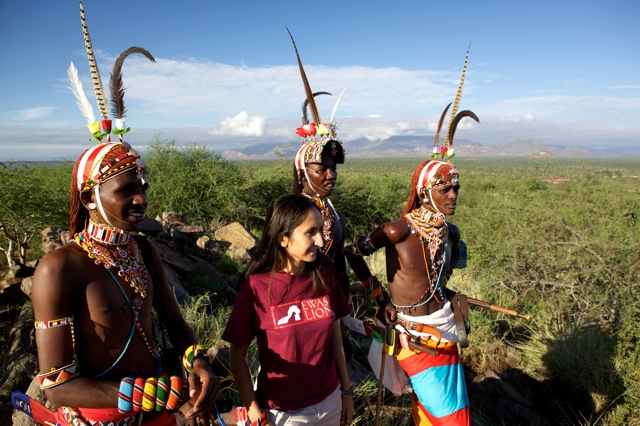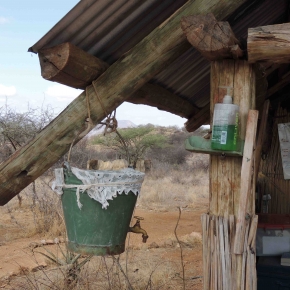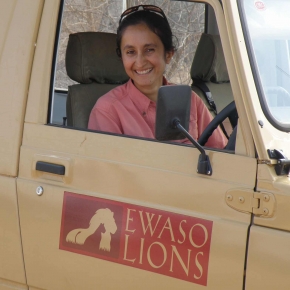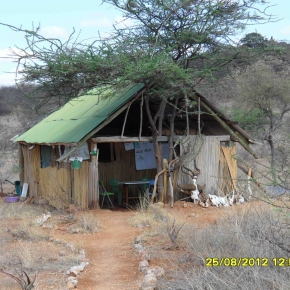
Shivani Bhalla may be tiny (barely over 5 feet tall), but her work (Ewaso Lions Project) on behalf of the animals and African tribes in Northern Kenya’s Samburu region is enormous.
On my recent trip to Africa, I spent the day on a wildlife drive with Shivani Bhalla looking for African lions, and asking her questions like – “What does it takes to live and work in the African bush, and are you ever afraid?”
The photos below may give you a hint about what it takes to live in the African bush and study lions.
Lori Robinson interviews Shivani Bhalla:
- What is the current state of lions in Africa? And what are the lions biggest threats?

Sink at Ewaso Lion Research Center. Photo: Bonnie Bartnick
Africa’s lion population is seriously threatened due to habitat loss and retaliatory killing of lions when the cats prey on livestock belonging to the local people. In Kenya alone, it has been estimated that there are less than 2,000 lions remaining in the country.
- One of my most popular posts is about a 13 year old who is saving lions in his village. Where did your desire to help the lions in Africa originate?
I moved to Samburu more than 10 years ago and realized how important and necessary African lion conservation was. No one had done any study before on lions here, so I started my project: Ewaso Lions. It was also at this time that a lioness had adopted a baby oryx antelope – a very unique event. I wanted to learn more about this female, and to identify the lions of Samburu.
3. What does it take to be you– to be an effective animal conservationist helping african animals?

My job is difficult and often unsafe – but extremely important as we are making a difference in protecting lions in the region. To be effective in helping wild animals, you need to be very dedicated and also need a lot of patience of working with the local African tribes who live with lions and other wild animals.
Finding lions here is hard work.
When I finally see one – it feels like I am seeing a lion for the very first time.
4. That makes sense because as you explained the lions in Samburu are not only smaller and lighter in color than in Masai Mara for instance but there are fewer of them. You mention your work is “often unsafe”. Are you ever afraid as a single woman living and working so close to lions?
Sometimes parts of our study area are unsafe, but I’m never afraid because I’m always with a team of Samburu warriors!
5. When people have the chance to experience animals in the wild, they are more likely to care about their welfare. That is why SavingWild.com supports bush learning programs for African kids. What is the best thing about living in the bush and having such close contact with wild animals and lions?
I love the freedom and the space that I get when living in the bush. Every day is new and different from the previous day. I love how I can never predict what the day will bring and which animals I will see.
6. What is the hardest part of your work – or your least favorite part?
One of the main challenges we face is the harsh and minimal field conditions where we work and live. Our bush camp is pretty rustic! We don’t have running water or power, porcupines often plunder our kitchen, and we live in canvas tents whose zippers are always breaking.
We don’t have any permanent structures so when the rains hit hard, our camp becomes a disaster zone!
Raising enough funds to keep our work going is an enormous challenge, especially as our project grows and expands into new territory. I have a superb field team in Samburu that work so hard to provide security for wildlife, and it is a huge responsibility to ensure that their salaries are paid and that funds continue to come in to run the project.
7. I know your work through Ewaso Lions has had such an impact on the local Samburu communities and their relationship to lions. But, worldwide, are our efforts in conservation working? Do we have time to do all we need to do to protect and save wild animals and wild places?

Ewaso Lion’s Headquarters. Photo: Judy Rossiter
I hope so! I am hopeful that there is still space for wild animals and time to protect them.
BUT people need to act fast and take an interest and start working towards conservation efforts. It takes dedication and passion for wildlife – and if everyone had it, we’d save a lot more places and animals.
YOU CAN VISIT EWASO LIONS
Contact Shivani Bhallathrough Ewaso Lions.
Set up an hour telephone consult with me, Lori Robinson to answer all your safari questions.
Featured image: credit Tony Allport
10 Replies to “Meet Shivani Bhalla of Ewaso Lions”
Comments are closed.

Hi, dear Lori,
I am so pleased that you are featuring Shivani. Nel and I and several other friends attended the Wildlife Conservation Network conference in SF last Fall and it was superb. Especially effective and compelling was Shivani. I introduced everyone to her after her presentation. She is as delightful and knowledgeable before an audience of hundreds as she was with us. What a treat.
I am herding the same group this Fall (Sat. October 12th) to the Mission Bay Conference center for an encore. Shivani will no doubt be there, too. It would be wonderful if you were able to come. Who knows, though? By then, you may be back to Africa with Africa Inside and outside you…..
Love, Linda
Hi Linda, I was so sorry to miss the event last year and hope to be there this year to see you and Shivani and everyone else.
I am so glad you have stayed in contact with Shivani after you took the trip to see her with AfricaInside. Good for you.
Thank you for sending me the link Lori. A most interesting article. Shivani leads a fascinating and rewarding life. I am thinking that in some ways Samburu has changed little since the days George Adamson was beating a path across its lands. Particularly so camp life. The dedication of people like Shivani is very inspirational, especially in these current times where the wild world is paying such a high and tragic price for mankind’s desire to ‘take, exploit and erase”….. My very best wishes to her and I hope more people and organizations get behind her and others whom are doing their utmost so that the wildlife and environs of the world have a chance of a stable future…
Love, love, love this interview! I absolutely love what she’s doing for lions. I especially enjoyed the part about the lioness adopting the baby oryx antelope – I find unique animal relationships like that so fascinating.
Thanks!
Britt
Hi Cam and Britt, thanks for your comments. I agree Cam on the dedication part. Just look at her ‘headquarters” photo and it explains everything about how she has to work out there. I love Samburu and the surrounds because not a lot of tourists go there compared to the Mara, Amboseli, Lewa, etc.
Britt, I asked Shivani for a photo of the oryx and lioness but she didnt have one. I love those unique relationships as well and wrote another post about a leopard and cow a while back called Big Cat Hero in case you are interested.
I enjoyed this, especially of course for having met Shivani. I love all your posts.
Every little helps – sorry couldn’t resist
Great story! I love all the press Shivani and her good work is getting.See you all in October at the conference!
Gosh, what a gift Shivani is to the lions! And all of us who treasure this creature.
Yes Lisa, she is wonderful and doing great work. I hope you will get to go visit her with me one day soon.